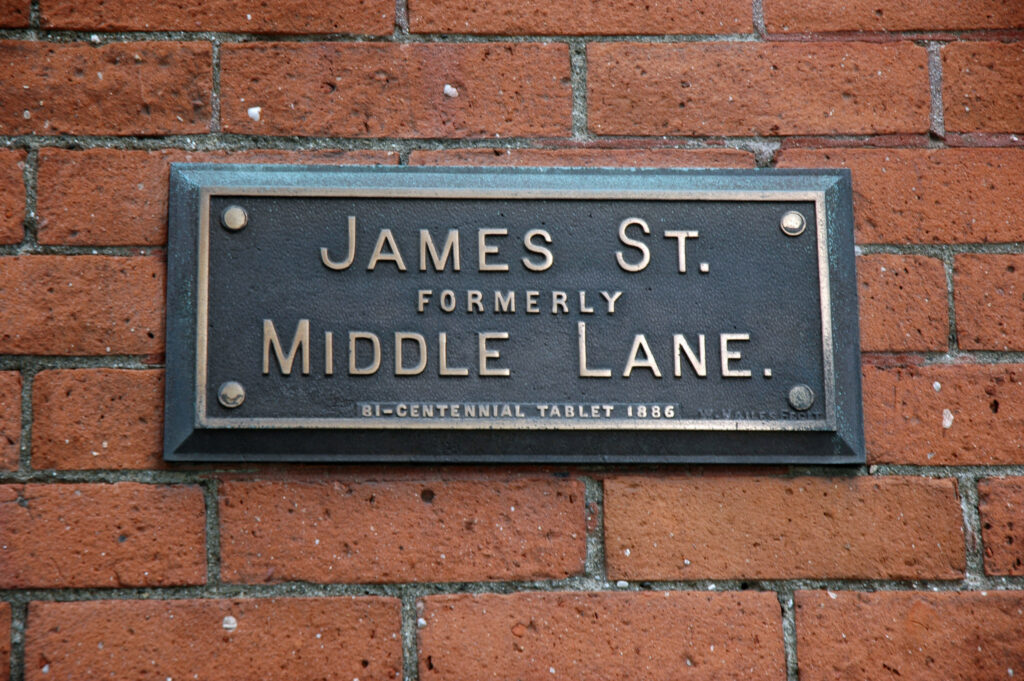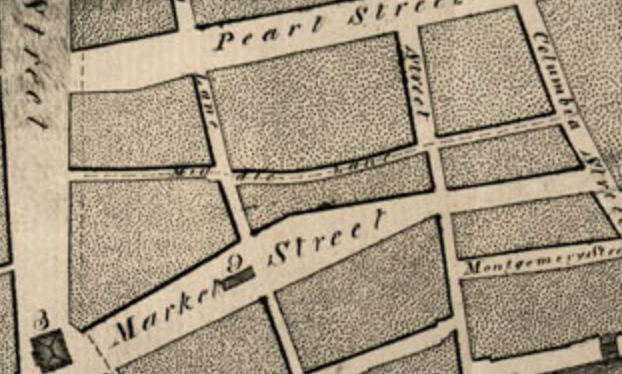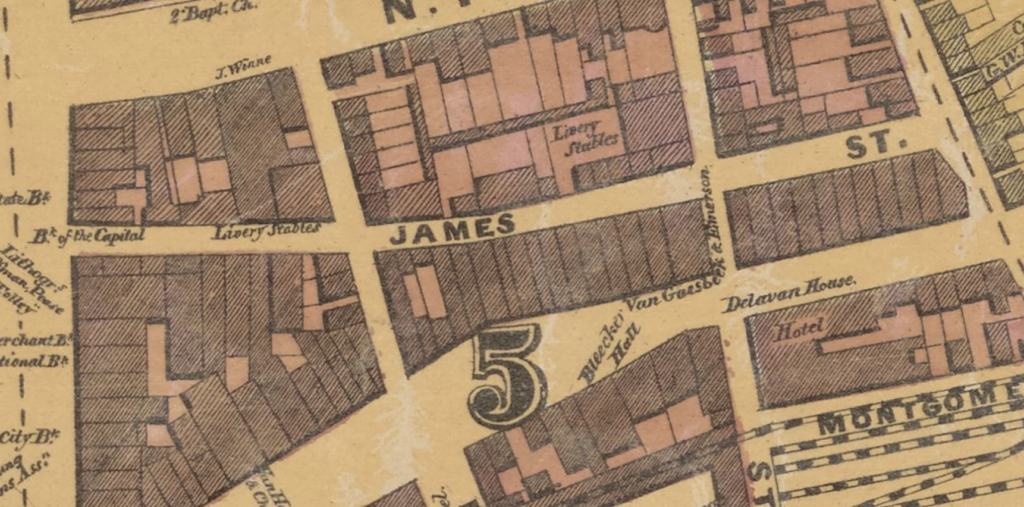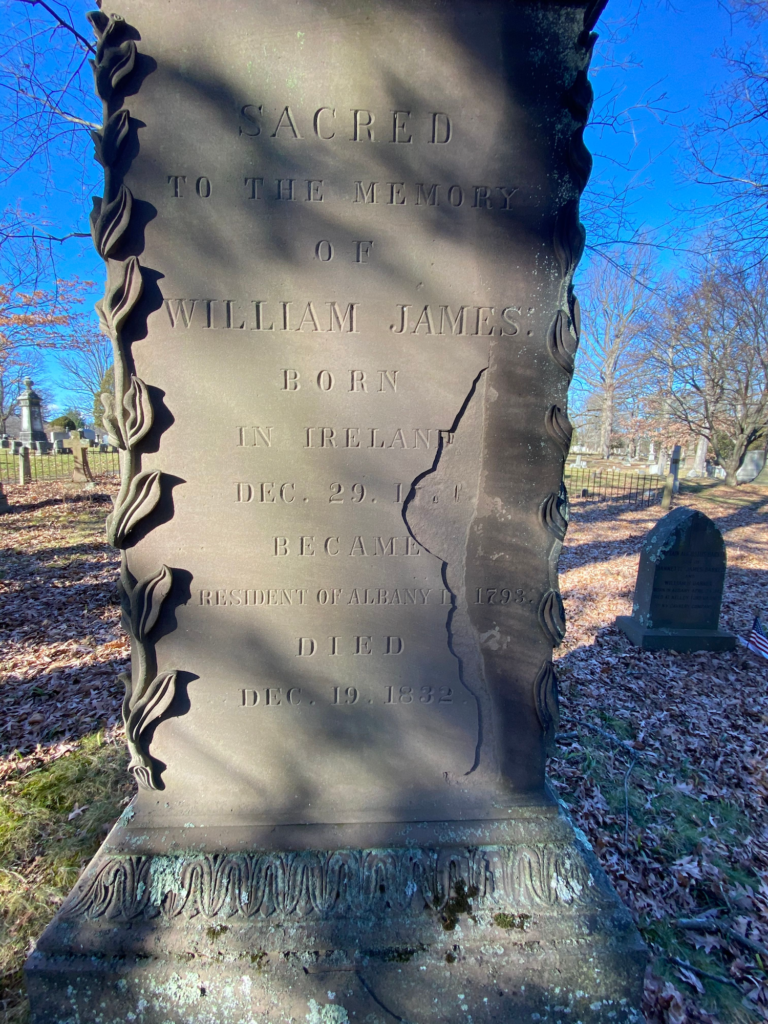Here we are at number 36 in our series of tablets placed in honor of Albany’s charter bicentennial in 1886.
Tablet No. 36—James Street.
Bronze tablet, 7×16 inches, on Mechanics and Farmers’ Bank. Inscription
“James Street, formerly Middle Lane.”
Similar to Dean Street, we’re a little mystified as to why the Albany Bicentennial Committee chose to commemorate little James Street with a plaque, without any explanation. However, we’re surprised and happy to say that the marker still exists:

According to Stefan Bielinski’s history of Albany streets, James was originally known as Middle Alley, Middle Lane or even Wagon Way. It only ever ran from Columbia south to State Street, serving as a rear access to buildings on either North Market (Broadway) or North Pearl streets. He indicated that it was probably renamed for William James, Albany merchant, father of theologian Henry James Sr., grandfather of the important 19th century novelist Henry James and the philosopher and father of American psychology, William James, as well as noted diarist Alice James.

George Rogers Howell’s “Bi-Centennial History of the County of Albany, 1609-1886” indicates that the change from Middle to James was among the many streets whose names changed after 1805. The 1794 Simeon DeWitt map shows it as Middle Lane; the 1857 Sprague-Dripps map shows it as James Street, and we have found newspaper references to James Street as early as 1843.

While the prolific writers Henry and William of the James family are still well-known, the founder of the family in America is less so, though he was the examplar of coming to America (born in County Cavan, Ireland in 1771) and making it rich. Bielinski credits traditional sources as saying James came to America in 1789, worked as a clerk in the dry goods store of John Robison in 1793, and was able to open his own store in 1795. He built a waterfront tobacco factory in 1798, and from there expanded his interests in various businesses and real estate all over Albany and beyond. His store at the corner of Green and State was a noted landmark; he had another full store on the docks, and after the Erie Canal opened he was involved in the establishment of a salt works at Jamesville near Syracuse.
In “The Rude Hand of Invention,” David G. Hackett put William James in the context of social and religious change taking place in Albany after the Revolution, as new immigrants and waves of New Englanders upset old Dutch precepts:
“William James’ career demonstrates the cycle of expanding growth and capital reinvestment that was characteristic of these newcomers. His decisions to open a store closer to the unloading of ships at the water’s edge, manufacture his own products, and engage in the trans-atlantic trade were similarly characteristic and radical departures from Albany’s traditional business practices.”
He became fabulously well-to-do. A 1932 Knickerbocker Press article reviewed a biography titled “The Three Jameses,” in which author C. Hartley Grattan wrote about the arrival of William James, “founder of the James dynasty in America,” at a time of transition between the Patroon system and the “new capitalism.”
“William James shared in both systems and illustrated a divided allegiance that must have been typical of his time, according to Mr. Grattan. When the elder James settled in Albany, Mr. Grattan explains, ‘the leading citizens were still, theoretically, the Dutch Patroons, whose wealth was in land and whose power was by nature agrarian in basis.’ But they were rapidly losing power . . .
“Probably no man contributed more to the early history of Albany than William James. He amassed a great fortune. He had property and stores all along the Hudson from New York to Syracuse. In 1815 he was made trustee of the Albany Academy and later chairman of the board. He was director of the New York State Bank at Albany and later vice president of the Albany Savings Bank, ‘the first institution of its kind in the state,’ according to Mr. Grattan. When the first Chamber of Commerce was organized in the city he was made vice president. He was a trustee of the First Presbyterian Church and Union College. His financial aid was chiefly responsible for the founding of the college, “the second college in the state, and the farthest West of any institution of that grade in America.’
“His whole life is interwoven with the founding of the city. James Street gets its name from his memory. He worked whole heartedly for the Erie Canal. Mr. Grattan quotes in detail speeches he delivered for the advancement of the canal. His will, a striking document, is on file in the Albany County Court House. In specifying the disposal of the vast estate he wrote that individual’s share could be lost if at the time of the division trustees were convinced that persons to benefit ‘lead a grossly immoral, idle, or dishonorable life.’
“William James’ grave is in the Albany Rural Cemetery. The Albany Evening Journal commenting upon his death said: ‘Mr. James’ death is a severe loss to the city of Albany. He had done more to build up the city than any other individual.”

James died at age 60, in 1832.
As a street, James has always been a minor feature of Albany, though it became significantly more visible when buildings on Broadway came down and, eventually, Tricentennial Park was established.

Leave a Reply